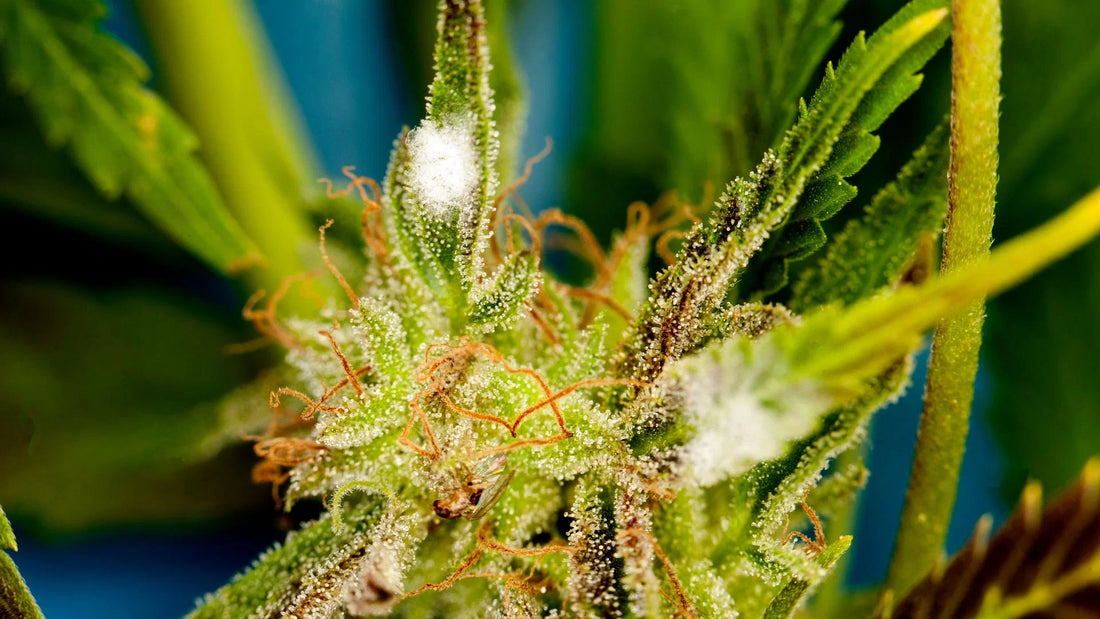
Identify And Treat Pathogenic Mold
Share
As a cannabis cultivator, you spend months caring for your plants, learning how to water, feed, and prune them properly. During this time, you may encounter pests such as insects or mould. Many organisms would like nothing better than to enjoy your plant.
One of the most difficult pests to deal with is mould. Several types of pathogenic fungi can wreak havoc on your crop, especially during these last few weeks of growth during the outdoor season. As temperatures dip and humidity rises, the environment becomes ideal for fungal growth. You can do several things to prevent these pathogens from ruining your harvest.
Many types of pathogenic mould can impact your harvest, from root rot to leaf spot, powdery mildew and bud rot. While preventative measures through an integrated pest management plan can reduce the likelihood of infection, fungal decomposition is perfectly natural. You can treat various moulds for improved harvest with the tips and tricks outlined in this article.
Identifying And Preventing Root Rot In Cannabis
Root rot is a pervasive and destructive issue that can plague cannabis plants, threatening the health of your entire crop. This condition can be caused by various pathogens, each with its unique characteristics. Among the primary culprits responsible for root rot are fungal pathogens like Fusarium, Pythium, and Rhizoctonia. These harmful microorganisms thrive in excessively moist or poorly drained soil, where they attack the root systems of cannabis plants. Fusarium is known for its ability to cause wilting, yellowing leaves, and root discolouration. Pythium is notorious for causing root rot in wet, soggy conditions, while Rhizoctonia often appears as dark lesions on the roots.
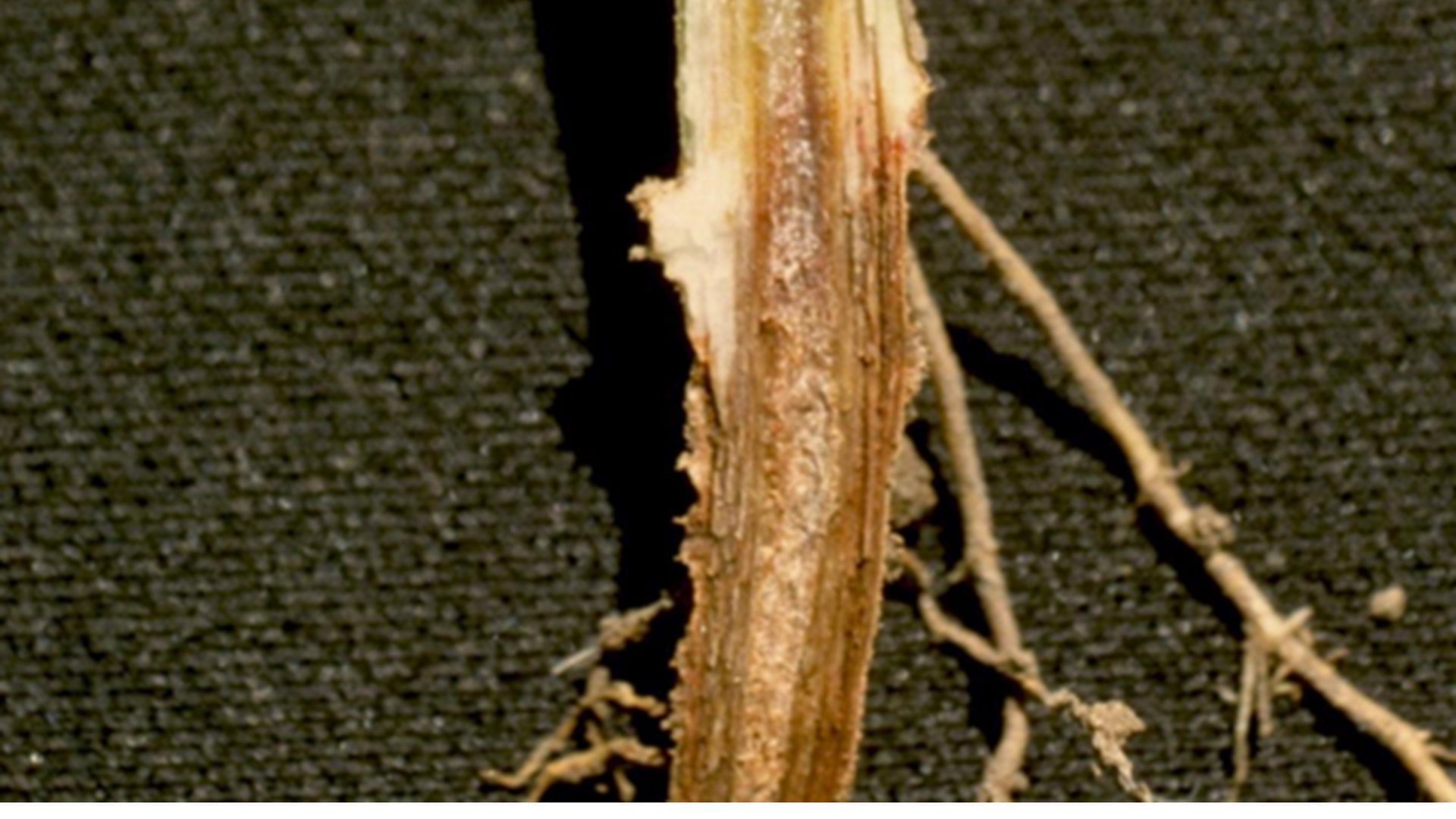
"Fusarium can cause significant damage to cannabis plants. This pathogen is known for its ability to spread quickly and infect plants through the roots, stems, and leaves. This pathogen thrives in warm, wet environments between 50-86F and can live in soil for 5-15 years. Once infected, a plant can lead to stunted growth, wilting, and even death if left untreated. There are several strains of this fungus, and they are grouped according to the type of disease they cause. (Fusarium stem canker, Fusarium wilt, etc.). Common symptoms include damping off seedlings, root rot, wilt, and cankers.
Identifying symptoms is difficult because of the wide range of damage that can occur - oftentimes too late to take effective action.
Fusarium can spread through soil, contaminated water, and plant debris. Once it enters a plant, it can cause wilting, yellowing, and necrosis of the leaves. The fungus also damages the vascular system of the plant, making it difficult for water and nutrients to flow properly. This can result in wilting and eventual death of the plant. – Excerpt from "The Organic Cannabis Pest Guide"
Prevention
Keep your soil at the proper moisture level, avoiding overwatering and sustaining a healthy microbiome in your soil. Maintaining a healthy soil food web reduces your odds of contracting root rot.
Treatment
Remove any infected material, sanitize your tools, allow your soil to dry out, and apply beneficial microorganisms that will outcompete and reduce the spread of infection. Trichoderma, Bacillus subtilis, Streptomyces lydicus, Pseudomonas chlororaphis.
Preventing And Treating Leaf Spot In Cannabis
Leaf spot, a common fungal disease affecting cannabis plants, can severely threaten your crop, particularly during flowering. Understanding how to prevent and treat this issue is vital for maintaining plant health and yield. Two pathogens primarily cause leaf spot: Septoria lycopersici and Cercospora cannabis. These fungi typically target the plant's lower (older) leaves, manifesting as small, yellowish circular spots with greyish-white centres and dark margins.
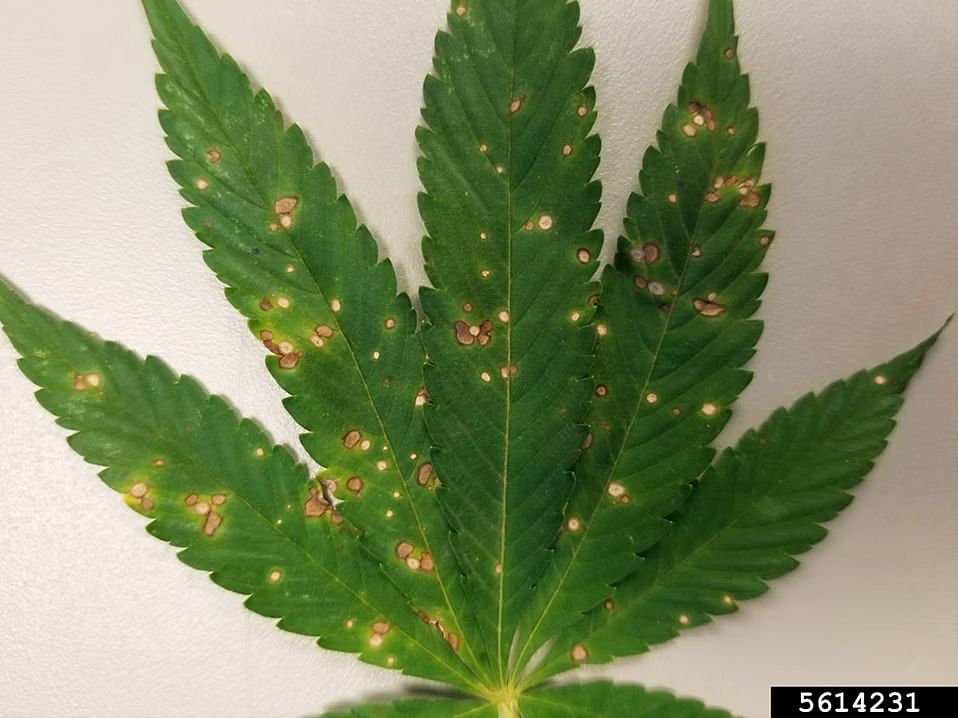
Prevention
It begins with maintaining a clean and dry environment. Leaf spot thrives in humid conditions, so ensure proper air circulation in your growing area and avoid overwatering. Removing infected leaves and keeping the site around the plant's debris-free can limit disease spread. Be cautious about water splashing onto foliage, which can aid spore transfer.
Balanced nutrition is another crucial preventive measure. Leaf spot is more likely to infect plants with low nitrogen levels. To reduce susceptibility, maintain a well-balanced nutrient ratio, and ensure your plants are healthy.
Biological controls can also play a crucial role in prevention. Incorporate beneficial microorganisms like Bacillus subtilis, Bacillus simplex, Bacillus megaterium, and Trichoderma harzianum into your cultivation practices. These organisms enhance your plant's natural defence against fungal diseases.
Treatment
Fungicides like copper-based products, neem oil, and sulfur sprays can effectively control leaf spot during the vegetative phase of growth.
Additionally, a foliar spray of baking soda, water, and soap has shown promise in combating Septoria. Some experiments have indicated that foliar applications of fish emulsion and neem oil can help reduce infection. However, exercise caution with chemical treatments, follow the instructions on the label meticulously, and avoid their use during the flowering stage to protect the taste and quality of your buds and ensure safety when consumed or combusted.
Hydrogen peroxide is the safest foliar treatment during the flowering growth phase because it will quickly degrade into water. Follow this with a foliar application of beneficial microorganisms to replace the microbiome you killed with hydrogen peroxide.
- Hydrogen Peroxide: Mix 1 cup of hydrogen peroxide with 4 gallons of water and apply as foliar. The dissociation of the oxygen molecule causes oxidative stress, essentially killing the fungal spore through cellular degradation.
Preventing And Treating Bud Rot In Cannabis
Bud rot, also known as grey mould or Botrytis, is a formidable fungal disease that poses a significant threat to cannabis cultivation. This destructive ailment, caused by the Botrytis cinerea fungus, can devastate cannabis crops, affecting the flowers, stems, and leaves. Preventing and addressing bud rot is crucial for preserving the quantity and quality of your cannabis harvest.
Botrytis thrives in cool and humid conditions, making it particularly problematic in greenhouse cannabis grows where controlling humidity can be challenging. Effective prevention strategies start with creating an environment that limits the growth and spread of this fungus.
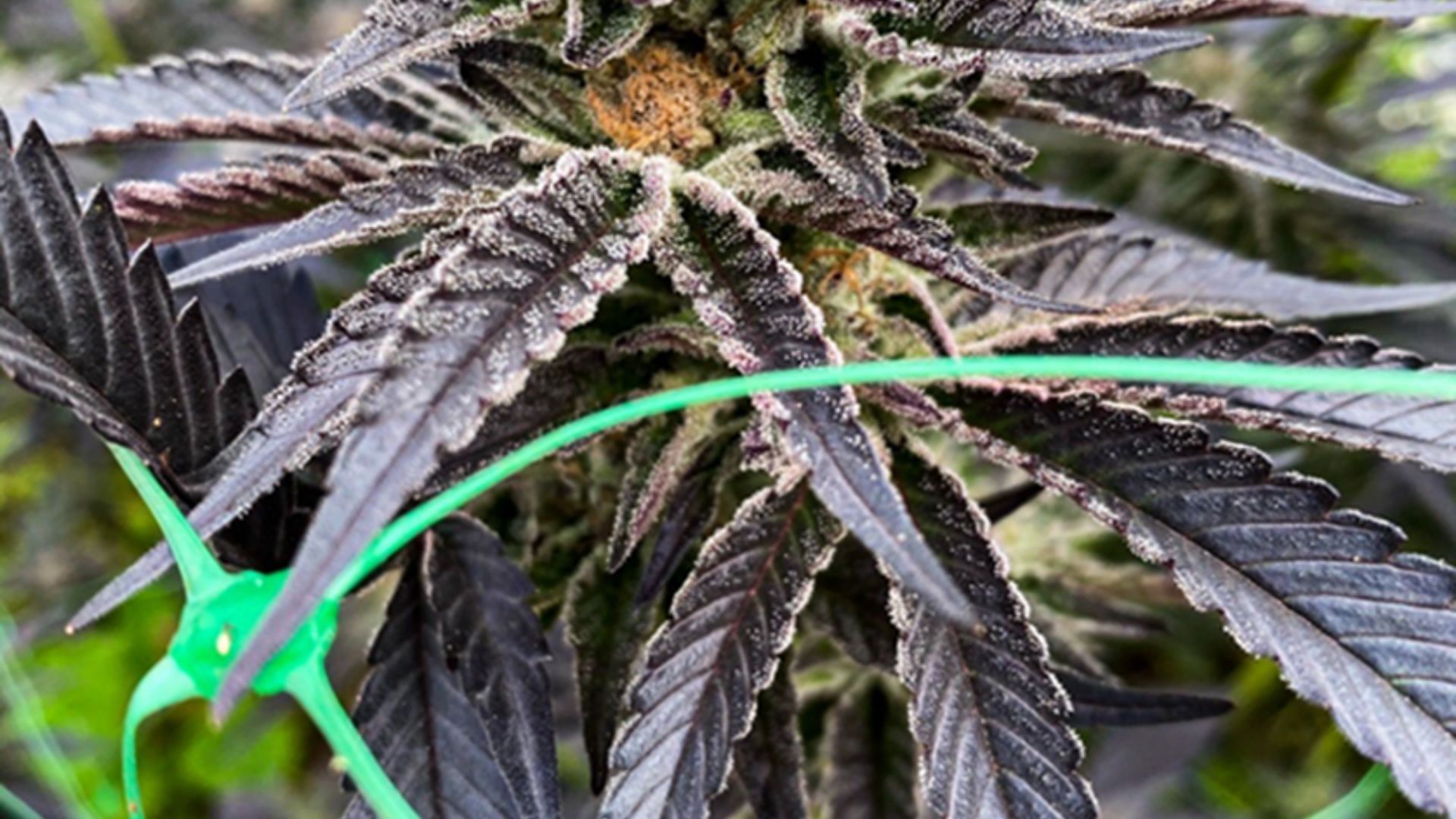
Prevention
Proper ventilation and airflow are essential to reduce humidity levels. This involves providing adequate spacing between plants and pruning them to ensure no obstacles to airflow. Using oscillating fans and intake and exhaust fans in greenhouses can help maintain optimal ventilation.
Regularly removing infected plant material is critical in preventing Botrytis from spreading. When you do this, consider covering the infected site with a paper towel saturated with isopropyl alcohol or hydrogen peroxide and immediately placing it into a paper bag for disposal.
Maintaining a clean growing environment and sanitizing tools and equipment can also limit the fungus spread.
Additionally, be gentle when handling your cannabis plants, as any damage to plant tissue can be an entry point for fungal spores, especially when environmental conditions favour their growth. Snapped branches, pruned leaves, and abrasions from trellising should be minimized when Botrytis is present.
Controlling caterpillar pests with Bacillus thuringiensis (BT) can also help manage Botrytis, as caterpillar damage often leads to Botrytis.
If Botrytis has taken hold in your garden, immediate and careful action is required to salvage your plants. Several treatment options are available but should be used as a last resort when preventive measures have failed.
Treatment
Biological controls can be adequate against Botrytis. Beneficial organisms like Trichoderma can outcompete Botrytis for resources, hindering its growth. Bacillus subtilis, a bacteria strain, can produce toxic antibiotics to Botrytis.
Chemical treatments, although an option, should be approached with caution.
- Hydrogen peroxide: It can be sprayed onto plants to kill the fungus, but it should be used carefully to avoid damaging the plant. Other chemical treatments, such as fungicides, should be avoided, as they can have adverse effects when ingested or smoked and may not be suitable for cannabis.
Preventing And Treating Powdery Mildew In Cannabis
Powdery mildew is a common fungal disease that can wreak havoc on cannabis plants, manifesting as a white, powdery substance on leaves, stems, and buds. If left unchecked, it can cause yellow spots, wilting, and significant damage to your crop. Here, we'll explore prevention and treatment strategies to combat this persistent menace.
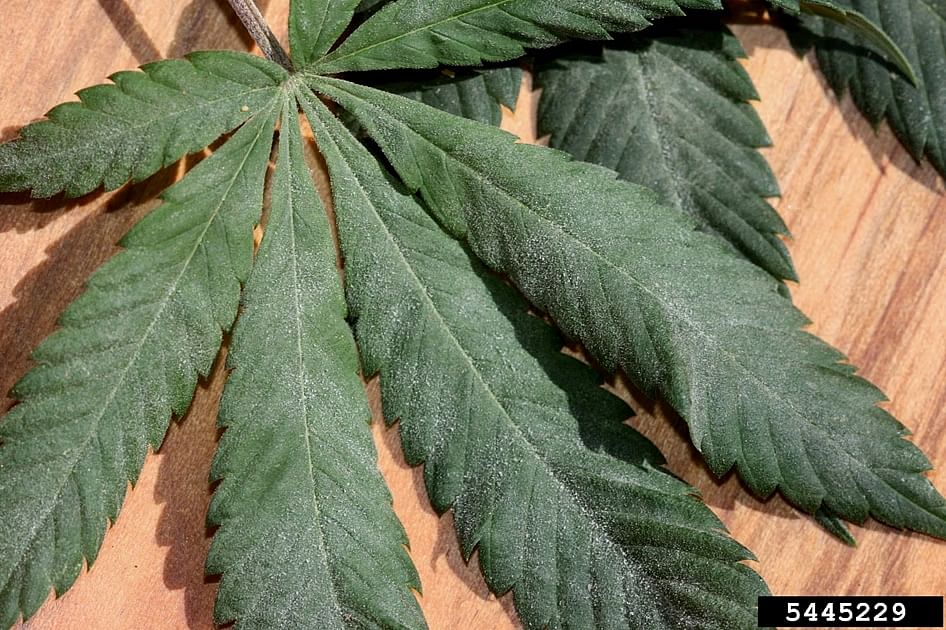
Prevention
Effective prevention of powdery mildew begins with cultural practices aimed at creating an environment less conducive to growth. These practices include regular pruning and thinning of the plant canopy to increase airflow and reduce humidity. Proper nutrient levels and adequate spacing between plants should be maintained to avoid overcrowding, which can foster fungal development.
Biological controls can play a crucial role in managing powdery mildew in cannabis. Beneficial microorganisms like Bacillus subtilis, Trichoderma harzianum, and Streptomyces lydicus have demonstrated suppressing the growth and spread of powdery mildew. These microorganisms can be introduced throughout the growing cycle, offering ongoing protection.
Treatment
Chemical treatments can provide a solution when powdery mildew strikes, but they should be used judiciously and carefully. Several options are available:
- Sulfur: Sulfur-based treatments work by inhibiting the growth and spread of the fungal pathogen. However, it's essential to note that sulfur cannot be used during the flowering stage.
Instead, it should be applied regularly throughout the vegetative cycle to prevent fungal pathogens from taking hold.
- Citric Acid or Baking Soda Sprays can effectively manage powdery mildew. These treatments alter the pH of the environment, creating conditions that inhibit the growth of the fungus. They can be applied during the vegetative stage to prevent and control powdery mildew.
Protecting Your Cannabis Crop From Fungal Pathogens
When safeguarding your cannabis crop against fungal pathogens, taking proactive measures is essential. Implementing a well-structured integrated pest management (IPM) plan is paramount for every cannabis gardener. Incorporating these practices reduces the risk of infection and promotes a thriving and healthy harvest.
To bolster your defences, consider weekly foliar applications of beneficial microorganisms during the flowering phase and sulfur-based foliar applications in the vegetative stage. These practices are invaluable components of an effective IPM strategy tailored to combat fungal pathogens in cannabis cultivation.
Moreover, knowledge is your ally. Understanding the lifecycle and preferred environmental conditions of specific pathogens equips you to make informed decisions in preventing and treating these issues. Stay vigilant, stay informed, and nurture your cannabis garden to ensure a flourishing and pathogen-resistant crop.
Cultivating Mold-Resistant Cannabis Strains With High Limonene Content
One strategy to protect your cannabis crop from mould and ensure the production of top-quality buds is to grow mould-resistant strains known for their high limonene content. Limonene is a terpene in various cannabis strains known for its citrusy aroma and potential mould-resistant properties.
Choosing The Right Strain
Start by researching cannabis strains known for their mould-resistant characteristics. Look for strains with a reputation for being resilient in high-humidity environments and resistant to common fungal pathogens. Some well-known mold-resistant strains include Blue Dream, Jack Herer, and Super Silver Haze.
Look for strains that are not only mould-resistant but also naturally high in limonene. Limonene is a terpene found in cannabis that not only contributes to the citrusy aroma but may also possess antifungal properties. These strains may offer an added layer of protection against mould. Selecting mould-resistant strains with high limonene content and implementing proper cultivation practices can reduce the risk of mould issues in your cannabis crop. However, no strain or technique can guarantee complete immunity to mould, so ongoing vigilance and a well-rounded IPM strategy are essential for maintaining a successful and mould-free cannabis garden.

